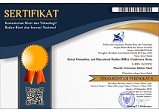Application of The Paikem Approach to Improve Vocabulary Material Learning Outcomes in SD Negeri 2 Karangwuni
Abstract
This study aims to increase understanding of vocabulary and their meanings by applying modeling techniques to grade II elementary school students. This study was designed in two cycles, with the research subjects of grade II students of SD N 2 Karangwuni in Pringsurat District, Temangggung Regency with a total number of students. 9 students. The research design used was the Classroom Action Research (PTK) spiral model from Kemmis and Taggart which included four stages of research, namely planning, implementing, observing, and reflecting. Students' understanding of the meaning of vocabulary has increased each cycle. Increased understanding of the meaning of students' vocabulary can be seen from the average cycle I only 66.6%. While in cycle II the average score increased by 88.8%. It was concluded that using the Paikem Approach which was carried out in accordance with the learning steps included the application of Active, Innovative, Creative, Effective, and Fun Learning, making learning conclusions, providing evaluation and closing the learning process in Indonesian subjects can improve student learning outcomes in grade 2 SD N 2 Karangwuni, Pringsurat District, Temanggung Regency Based on this research, teachers should be able to choose a learning model that is in accordance with the character of students, so that students are motivated to learn, so that students are able to understand subject matter and interesting.
Keywords
Full Text:
PDFRefbacks
- There are currently no refbacks.




